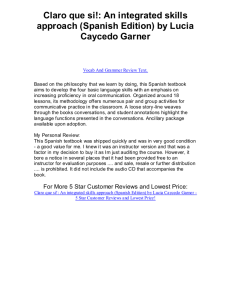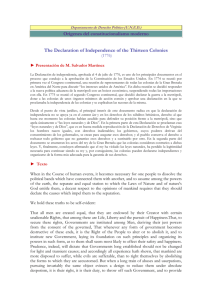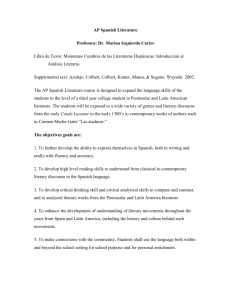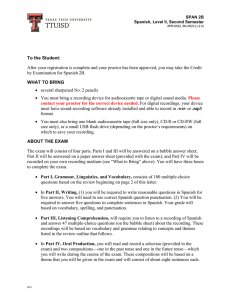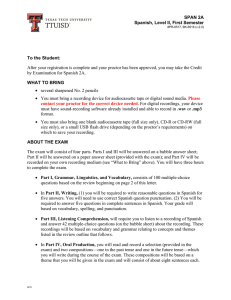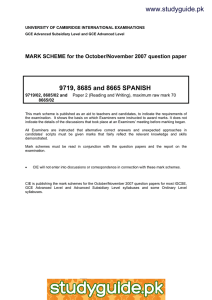The Spiritual Conquest of the New World
advertisement
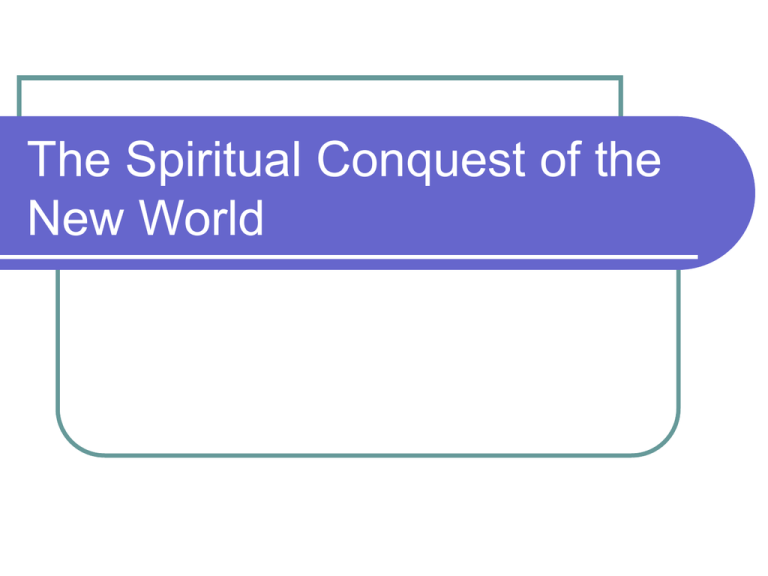
The Spiritual Conquest of the New World Introduction: The Spanish Reconquest and Militant Christianity Roman and Visigothic Spain Moorish Invasion, 7 11 A.D. Santiago Campostelo Commencement of Reconquest To Granada, 1492 The Origins of Christianity in the New World Voyages of Christopher Columbus Searching for Sea Route to the East (see maps next slide) Struck the Americas Instead Set the Stage for the Spanish Conquest The Caribbean Sea, islands and adjoining mainlands where Catholicism first arrived. Isabella the Catholic Bulls of Pope Alexander VI, May, 1493 “The Papal donation” [to next page] La primera bula «Inter coetera» de Alejandro VI(1) 3 de mayo de 1493 El documento cuya traducción damos a continuación ha tenido un peso notabilísimo en la historia de la presencia de España en América. El mismo sirvió durante mucho tiempo como base jurídica del dominio español sobre las tierras descubiertas por Cristóbal Colón en 1492 e impropiamente llamadas "las Indias". El Sumo Pontífice, después de alabar el celo apostólico de los reyes Fernando de Aragón e Isabel de Castilla, su deseo de extender la fe católica, deseo que había quedado patente con la entonces reciente recuperación del reino de Granada de manos de los árabes, reconoce finalmente el papel fundamental que les ha cabido en la empresa colombina; atendiendo pues a todos estos antecedentes y haciendo uso de la "plenitud de la autoridad apostólica" resuelve donar y conceder las tierras recientemente descubiertas y las que en el futuro se descubrieran a los reyes Isabel y Fernando y a sus legítimos sucesores en las coronas de Castilla y Aragón, imponiéndoles al mismo tiempo la obligación de evangelizar a los pobladores de dichas tierras. Mucho se ha discutido sobre el fundamento jurídico en el que se apoyó el papa Borja para hacer semejante "donación", algunos autores quieren ver en este documento un exponente preclaro del monismo hierocrático, mientras que otros ven en él un simple mandato misionero(2). Lo que parece incontrovertible es que los reyes españoles solicitaron este documento a la Sede Apostólica con la finalidad de resguardar a los territorios recientemente descubiertos, de las posibles pretensiones de otros príncipes cristianos(3). Treaty of Tordesillas [go to link] In the meantime, Spaniards and Indians…. Tainos Arawak The Encomienda "The natives, finding themselves intolerably oppressed and overworked, with no chance of regaining their liberty, with sighs and tears longed for death. Many went into the woods and having killed their children, hanged themselves, saying it was far better to die than to live so miserably serving such ferocious tyrants and villainous thieves... finally, out of two million inhabitants, through suicides and other deaths occasioned by the excessive labour and cruelties imposed by the Spanish, there are not a hundred and fifty now to be found." Theodore De Bry included a graphic engraving with this text, illustrating the various methods of suicide, from hanging to clubbing children to death to selfmutilation. Such images, along with other evidence such as Las Casa's Brief Account of the Destruction of the Indies (1552) Origins of the Black Legend 1511 The Sermon of Father Antonio de Montesinos, OP Montesinos in His Own Words SECOND SUNDAY OF ADVENT, 1511--"I am the voice of one crying in the wilderness...You are in mortal sin and live and die in it because of the cruelty and tyranny that you use against these innocent peoples. Tell me, by what right, with what justice do you hold these Indians in such cruel and horrible servitude? On what authority have you waged such detestable wars on these peoples, in their mild and peaceful lands, where you have consumed such infinitudes of them, wreaking upon them this death and unheard-of havoc?....And what care do you take that anyone catechize them, so that they may come to know their God and Creator, be baptized, hear Mass, observe Sundays and Holy Days? Are they not human beings? Have they no rational souls? Are you not obligated to love them as you love yourselves? Do you not understand this?...How is it that you sleep so soundly, so lethargically?" The Epiphany of Bartolomé de las Casas Cuba, 1514 Massacre at the River Caonao Early Christianization of the Indies (Part 1) The regular orders: Franciscans, Dominicans, Augustinians Secular clergy Christianization as the context for conquest and colonization, no matter how contrived and hypocritical in some instances. Syncretic forms of Christianity Church of Santo Domingo, Cuzco, Peru SANTO DOMINGO CHURCH and CONVENT Due to the significant participation of the Dominicans in the conquest of Peru, the Spaniards couldn't have chosen a better place to build the church of the order than over the base of the most important monument of the Tawantinsuyo: the Koricancha, which is the largest Indian temple to worship the Sun. According to the chronicles, it was one of the most magnificent constructions of the Incan Cusco. In the inner part, the precincts' walls, made of finely polished stone, were entirely covered with gold and silver sheets, idols and the representation of the sun. After receiving the old temple's plot during the lots distribution that took place in October 1534, Juan Pizarro, brother of the conqueror, ceded it to the Dominican congregation. The first prior of the convent was Friar Juan de Olías, who occupied this cloister together with a group of Mexican missionaries. [next page for image] Another Form of Syncretism, Mestizaje The Revelations exhibition includes paintings depicting the colonial caste system, which described the complex racial mixing of the people of Latin America. Above, De Mestizo y de India, Coyote — or "A mestizo and an Indian woman produce a coyote" — 1763, Mexico. Christianity in Spanish Colonial America Real Patronato, or Royal Patronage Missionary orders vs. secular clergy Syncretism (already mentioned) All layers of culture and society imbued with Christianity Education Charity/Philanthropy (cont. with next slide) Christianity in Spanish Colonial America, 2 Hospitals Festivals Church leading financial institution Expansion of monastic life across urban Latin America Inquisition Control of wealth, haciendas, Jesuits, Paraguay, Mexico for example Beginnings of loss of prestige and power in eighteenth century Christianity in Spanish Colonial America, 3 Expulsion of the Jesuits, mid-eighteenth century Presence of missionaries as frontier institutions in North America, those lands that later passed to the United States. Frontier society and competition for Indian loyalties by Europeans, etc. To the Wars of Independence





